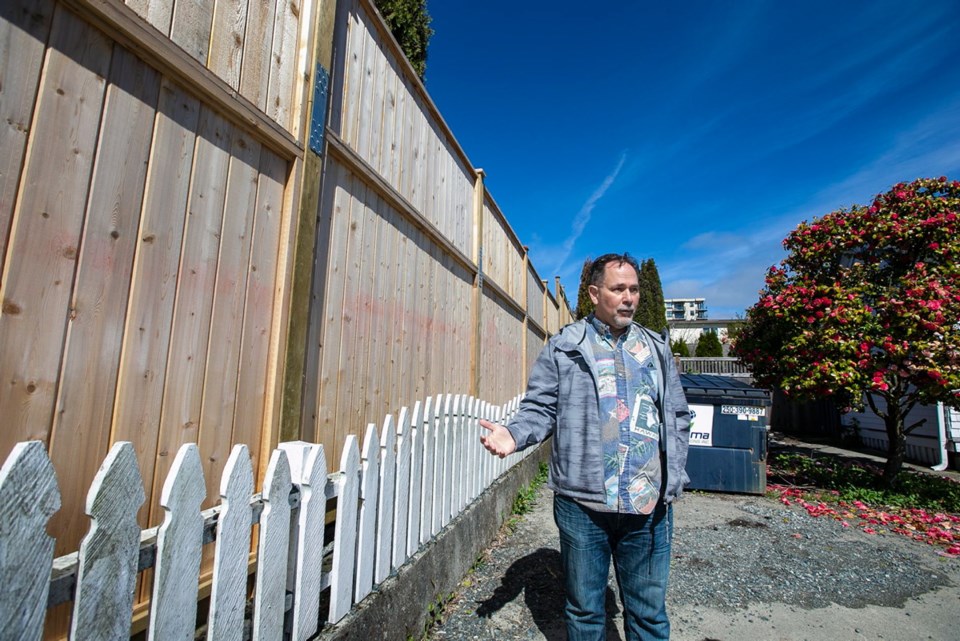The white picket fence of Sandy Bartlett’s tidy heritage home is dwarfed by a nine-foot wooden structure surrounding the modular housing project at 250 Terminal Ave. North in downtown Nanaimo.
The taller wooden fence was extended from six feet to nine in January to prevent non-residents from climbing over and, in some cases, buying or selling drugs.
Bartlett called Nanaimo RCMP on Friday after a portion of his picket fence was ripped off and used as a makeshift ladder to access Newcastle Place, which houses 76 people who previously lived in Nanaimo’s tent city.
It’s a small snapshot of the daily frustrations faced by Bartlett, who runs a law firm out of the heritage home, bordering on the back of Newcastle Place. Another provincially owned modular housing facility is located at 2060 Labieux Rd., about a five-kilometre drive away.
Neighbours say there has been a dramatic increase in crime and social disorder, which is reflected in a spike in police calls for service. But those who run the supportive housing facilities are asking the community for patience while they work to provide proper support for people struggling with drug addiction and mental-health issues.
As the B.C. government looks to modular homes as a quick way to deal with homelessness and tent cities — with $367 million earmarked for 2,200 modular units — the success or failure of these two Nanaimo facilities could provide a test case for similar projects across the province.
A Paladin security guard circles the block around the low-slung modular homes on Terminal Avenue while Bartlett lists the ways his life has changed since the supportive housing facility, run by Island Crisis Care Society, opened next door in December.
His employees have had valuables stolen from their cars, needles have been found in the parking lot and staff have watched drug deals go down in the White Spot parking lot across the street. Bartlett estimates the white clapboard-sided home at the corner of Vancouver and Bryden streets is now worthless, a far cry from the $1 million offered to him by developers before the neighbouring property was purchased by the province for modular housing.
Bartlett is not angry at the former tent city residents, but at the province for plunking down low-barrier modular housing in a residential area without proper supports.
“We are the frontline here,” he said. “There’s a serious problem here but everyone wants to say ‘it’s not as bad as tent city.’”
Bartlett feels complaints to City of Nanaimo council have fallen on deaf ears, as councillors say modular housing is a provincial responsibility. He encourages Housing Minister Selina Robinson to take a tour of the neighbourhood to understand the community concerns.
In addition to the higher fence, changes have been made to control access to and from the modular homes. Residents can now only access the facility through a shipping container which is equipped with a fob system and security cameras. That was thanks to the work of a community advisory committee, comprised of nearby residents, business owners, staff with Island Crisis Care, B.C. Housing, Island Health, Nanaimo city staff and Nanaimo RCMP.
Karen Kuwica, who sits on the committee and lives near the Terminal Avenue site, said in addition to drug dealing, she’s worried about fire hazards in the facility. There was a fire inside one of the units on Monday, displacing 20 people.
“You’re putting high risk people in a residential neighbourhood that’s low risk,” Kuwica said. “It’s an unreasonable burden to put on a neighbourhood. I’m worried for my safety.”
Violet Hayes, executive director of Island Crisis Care Society, said staff is doing everything they can to ensure the community is safe. Staff is responding to the community’s concerns through the community advisory committee and problem residents have been evicted, she said.
While progress can be slow, Hayes is seeing improvements among residents.
About 23 of the 76 residents have expressed an interest in addiction treatment and some have already gone into detox, she said.
Residents are planning to build a community garden and have made use of the facility’s library.
“We’re really hoping we can make a difference in their lives,” Hayes said.
Outside the modular homes on Labieux Road, a petite blond woman wearing a fluorescent safety vest picks up garbage along the sidewalk as cars whiz by.
Vicki Tardif, 50, lived in the mud and squalour of Discontent City until December, when she moved into a modular unit with her partner. The modular housing facility, dubbed Nikao, is run by Pacifica Housing and is sandwiched between provincial government buildings and the Nanaimo public works office. It backs onto the Island Highway.
Tardif, who works on the clean-up crew twice a week in exchange for gift cards, said she’s well aware of tensions in the community and the spike in calls to police.
“I’m surprised because it’s an industrial area, it’s not residential so I thought this was the perfect location for it,” she said. Tardif said she’s seen police hiding in the bushes and citizens on patrol taking pictures of residents.
“Addicts have to live somewhere, just like everyone else,” said Tardif, who has lived on and off the street for the last four years.
She’s focused on improving her health and she said having a stable place to live can help her get there.
David Dornian witnessed first-hand the trap of addiction as he watched a close family member attempt to break a heroin addiction. But as a property manager for two condo buildings on Country Club Drive and a plaza full of businesses on the Island Highway, the persistent problem with break-ins, mischief and drug dealing has caused his patience to wear thin. His wife was called a vulgar word and threatened when she yelled at someone rummaging through vehicles. He’s caught people ripping off patio screen doors and tampering with water pipes to try to access copper.
Since he joined a neighbourhood block watch, Dornian said police have been quicker to respond to his calls and he hopes the situation will gradually improve.
Nanaimo RCMP spokesman Const. Gary O’Brien said the detachment is acutely aware of public frustration as a result of the two supportive housing projects, which were hastily set up to meet the court-imposed shutdown of tent city.
The detachment is creating a task force of up to six officers who will crack down on criminal activity. O’Brien, who heads the block watch program, has seen a positive change in people now living in supportive housing. Police dealt with one tent city resident 48 times in six months when he was living at the tent city. Since he’s been in modular housing, police haven’t received a single call about him and he’s now part of a volunteer clean-up team.
Hayes acknowledges there’s a heightened sense of fear among residents, but asks: “What’s the alternative? To be on the street or to have another tent city? That’s not OK, either. These people deserve a home.”



